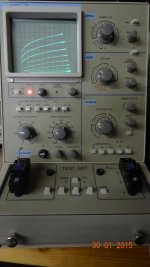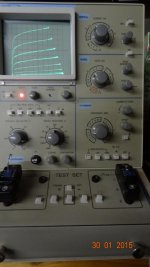Also, a very large noise increase occures only at 10Hz band when you blow across the device. So a room with no breeze (A/C etc) has to be used.
A definitive statement can not be made with "casual" measurements.
Tom - cool, I took some image processing classes with one of the folks who worked on fixing the Hubble images with software before they fixed the secondary mirror.
Hi Bonsai,
It isnt practical for me to do that number of tests.... just because of the time involved in doing it with the QuanTech. The worst part for me is I also have to solder leads onto each jFET to insert into the test machine.
But I did run the current up and down and voltage up and down.... little noise change with voltage. The current below 5mA causes the noise at 100 and 10Hz in particular to increase significantly, as I said.
I would have to look into the testing differences between others' test results and the QuanTech results to figure out why the difference shown at low freqs. If there are any such test differences.
THx-RNMarsh
No problem - the fact that you have confirmed low noise at audio is good enough.
A definitive statement can not be made with "casual" measurements.
its my way of saying same thing.... temp not at a standard temp nor controlled which it appears from casual tests, must be better controlled. Something for DIY to think about.
Interesting to me is that only 10Hz band is materially affected. Why is that?
THx-RNMarsh
Last edited:
No problem - the fact that you have confirmed low noise at audio is good enough.
That is what I wanted to do... not write a spec for publication.
-RM
Hi Guys
Regarding my comment on thermo-electric cooling as used in CCD astrocameras and it’s suggested possible use in low noise audio, I looked a bit, there has been some work in this direction for other uses and even lower temperatures.
If low noise is a concern, one or more of you fellows might want to look at the implications of this math and being relatively easy to cool things to well below freezing silently.
http://www.eng.auburn.edu/~wilambm/pap/2011/K10147_C011.pdf
http://pessina.mib.infn.it/Biblio/Biblio_Articoli/SPIE Volume N.5470 p 486 496 2004.pdf
http://www.mpi-hd.mpg.de/gerda/public/2008/c08_IEEE_dresden_preamp_fc.pdf
With this kind of solid state device;
Thermoelectric cooling - Wikipedia, the free encyclopedia
https://tetech.com/peltier-thermoelectric-cooler-modules/
Hi Scott
Man that sounds cool, that is an amazing hardware!!. Does that used filters too? mine use Luminance R, G and B filers to make a color picture.
As for my scale of things, it's like spinning a bunch of plates on poles, sometimes everything works right and you can stack a pile of exposures and get a decent picture, but, at best faintly like the Hubble pictures. On the other hand it is fun getting it all to go.
Regarding my comment on thermo-electric cooling as used in CCD astrocameras and it’s suggested possible use in low noise audio, I looked a bit, there has been some work in this direction for other uses and even lower temperatures.
If low noise is a concern, one or more of you fellows might want to look at the implications of this math and being relatively easy to cool things to well below freezing silently.
http://www.eng.auburn.edu/~wilambm/pap/2011/K10147_C011.pdf
http://pessina.mib.infn.it/Biblio/Biblio_Articoli/SPIE Volume N.5470 p 486 496 2004.pdf
http://www.mpi-hd.mpg.de/gerda/public/2008/c08_IEEE_dresden_preamp_fc.pdf
With this kind of solid state device;
Thermoelectric cooling - Wikipedia, the free encyclopedia
https://tetech.com/peltier-thermoelectric-cooler-modules/
Hi Scott
Man that sounds cool, that is an amazing hardware!!. Does that used filters too? mine use Luminance R, G and B filers to make a color picture.
As for my scale of things, it's like spinning a bunch of plates on poles, sometimes everything works right and you can stack a pile of exposures and get a decent picture, but, at best faintly like the Hubble pictures. On the other hand it is fun getting it all to go.
It looks like the very small packages are much more easily affected (faster response) by temp changes.
It is quit a good LF/HF device. From the limited number of them that I have.... the noise starts to increase below 1-2mA. So, I would use it at 2mA or higher if one is being picky about noise.
I should test some LSK170 devices I have, also... let you know when I got something for you.
THx-RNMarsh
It is quit a good LF/HF device. From the limited number of them that I have.... the noise starts to increase below 1-2mA. So, I would use it at 2mA or higher if one is being picky about noise.
I should test some LSK170 devices I have, also... let you know when I got something for you.
THx-RNMarsh
Last edited:
the LSK170B was just tested --- btw - it is very much less susceptible to temp changes.
10Hz 100Hz 1KHz 10KHz 100KHz
1mA/5v:
4.5nv 4.8nV 1.3nV .9nV .8nV
2mA/5v:
4.6nV 2nV 1.5nV 1.4nV .7nV
6mA/5v:
4.5nV 1.6nV .9nV .7nV .6nV
No signs of popcorn noise at LF. Obtained via sample.
THx-RNMarsh
10Hz 100Hz 1KHz 10KHz 100KHz
1mA/5v:
4.5nv 4.8nV 1.3nV .9nV .8nV
2mA/5v:
4.6nV 2nV 1.5nV 1.4nV .7nV
6mA/5v:
4.5nV 1.6nV .9nV .7nV .6nV
No signs of popcorn noise at LF. Obtained via sample.
THx-RNMarsh
Last edited:
temp sensitivity to change test.... here is the scientific method used:
I blow on it from about a foot away and watch the 10Hz noise meter response;
The tiny package would instantly peg the noise meter needle to the right.
The LSK package would barely move the needle.
Science at its best
THx-RNMarsh
I blow on it from about a foot away and watch the 10Hz noise meter response;
The tiny package would instantly peg the noise meter needle to the right.
The LSK package would barely move the needle.
Science at its best
THx-RNMarsh
temp sensitivity to change test.... here is the scientific method used:
I blow on it from about a foot away and watch the 10Hz noise meter response;
The tiny package would instantly peg the noise meter needle to the right.
The LSK package would barely move the needle.
Science at its best
THx-RNMarsh
It's triboelectric effect.
The only way to prevent it is by the introduction of VOC's which are conductive.
Chopin, Stoli, perhaps absolute...
Now THAT's the scientific method.
jn
In a "real" circuit is it likely that the small package would be in contact with something that would help keep its temperature more stable, like a copper pad on PCB, or PCB itself?
I bring it up because the temp sens seems so extreme (compared to TH parts) for these tiny little parts that one might need to be sure to consider stability of bias, gains, freq etc, besides noise changes in SIM's and in build.
THx-RNMarsh
Last edited:
Hi Scott
Man that sounds cool, that is an amazing hardware!!. Does that used filters too? mine use Luminance R, G and B filers to make a color picture.
As for my scale of things, it's like spinning a bunch of plates on poles, sometimes everything works right and you can stack a pile of exposures and get a decent picture, but, at best faintly like the Hubble pictures. On the other hand it is fun getting it all to go.
AFAIK there were no natural (real) color cameras on Hubble. Not much scientific info in color data from those types of filters (the nice picture type) mostly good PR generated by false coloring was done post facto (so I was told).
When I made measurements like these I used a modified version of Mr Wurcers X1000 amplifier on a PCB and stuffed the whole works in a paint can with BNC connectors in and out. The results then became pretty repeatable after letting things settle. Keeps the air stable and warm.
When I made measurements like these I used a modified version of Mr Wurcers X1000 amplifier on a PCB and stuffed the whole works in a paint can with BNC connectors in and out. The results then became pretty repeatable after letting things settle. Keeps the air stable and warm.
I mentioned before a very good designer at MTS instruments postulated that there was some limit to low frequency noise performance based on metallurgy of the interconnects and the heat dissipation of an IC. He did not have the physics background to pursue it. They made active counterweights to stabilize very tall buildings under wind load, failure was not an option.
When I was a youngster, I had been responsible for a one-off SEM --- its' front-end/detector had an input FET bathed in LN. It was so quiet and steady that I could see molecules and round clumps of basic elements stuck together which made the molecule.
back to audio --- It is nice to get averaged noise figures; makes for best specs. But, we should also get p-p noise levels and compare them as well.
Because: I suspect that BF has higher p-p levels than the LSK does. Especially, if there is popcorn noise involved.
THx-RNMarsh
back to audio --- It is nice to get averaged noise figures; makes for best specs. But, we should also get p-p noise levels and compare them as well.
Because: I suspect that BF has higher p-p levels than the LSK does. Especially, if there is popcorn noise involved.
THx-RNMarsh
Last edited:
Curve tracer of the LSK device and the BF second; First is with 0.5 mA/div and the second is 1.0mA/div. If not for noise, run them both up a few Iq milliamps to get more linear region for some designs.
[you can zoom in on the HiDef pictures]
View attachment 462571
View attachment 462572
THx-RNMarsh
Dick what are you trying to prove? Questioning my design decisions on applications other than audio? I can safely ignore these inputs and will.
No Scott. I have no info on your design/decisions on apps other than audio nor what transistors nor IC you use in your apps. Just on what I see talked about here in Diyaudio. Sorry, I just dont follow your designs that much.
The info is for those people who want to use the BF type being discussed for thier app/design.... starting with Waly's warning re, noise.
THx-RNMarsh
The info is for those people who want to use the BF type being discussed for thier app/design.... starting with Waly's warning re, noise.
THx-RNMarsh
Last edited:
AFAIK there were no natural (real) color cameras on Hubble. Not much scientific info in color data from those types of filters (the nice picture type) mostly good PR generated by false coloring was done post facto (so I was told).
That kind of begs a question, or maybe a bunch of questions. When we point a camera at the heavens we capture radiation over a very broad spectrum, certainly wider than what human eyes can capture. (WOW! Just like microphones can capture vibrations in the air over a much wider bandwidth than the human ear can perceive!) So how do we want to present that data? Showing a slide that is uniformly black (to our pathetic human eyes) isn't very helpful. Presenting images that are band-limited to our human vision limits isn't much better, but the "image data" is still essentially "visual" in nature, even when it is at frequencies that we can't perceive. Finding ways to present the out-of-visual-band information visually helps us to understand the data. Hence the "dressing up" of the data, false coloring, etc. It may confuse naive viewers, but it helps some of us to "see" what we are looking at, even when it is not visible to the human eye.
- Status
- Not open for further replies.
- Home
- Member Areas
- The Lounge
- John Curl's Blowtorch preamplifier part II

